The masterpiece I mentioned when finishing the previous part of the story is Bhagiratha’s Penance, also known as the Descent of the Ganges. This is a famous bas-relief on the rock that depicts how goddess Ganga descended from the heavens to the earth in the form of the holy river Ganges, all thanks to the penance of wise man Bhagiratha.
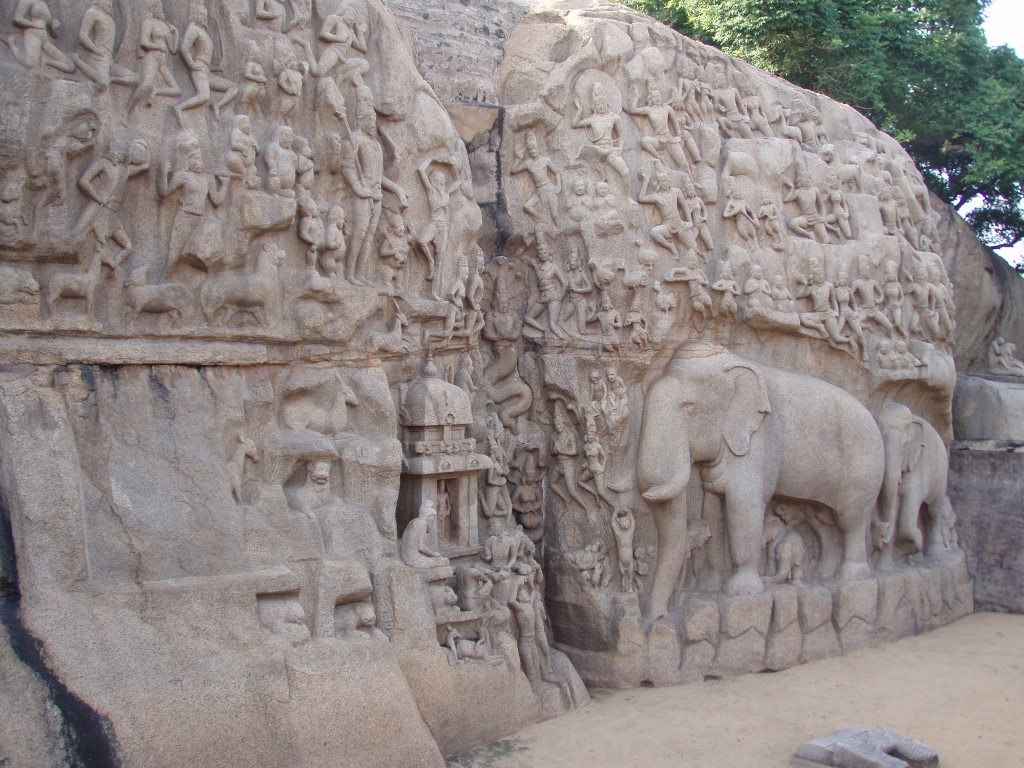 Bhagiratha’s Penance
Bhagiratha’s Penance
The bas-relief shows this entire story together with all the symbols and complex elements and characters so typical of Hinduism and the entire legend gets its dramatic visual depiction at the time of the monsoons when the rainfall, as the symbolic Ganges, flows down the natural cleft that exists in the rock.
 Bhagiratha’s Penance, the cleft between the two rock panels is completely natural
Bhagiratha’s Penance, the cleft between the two rock panels is completely natural
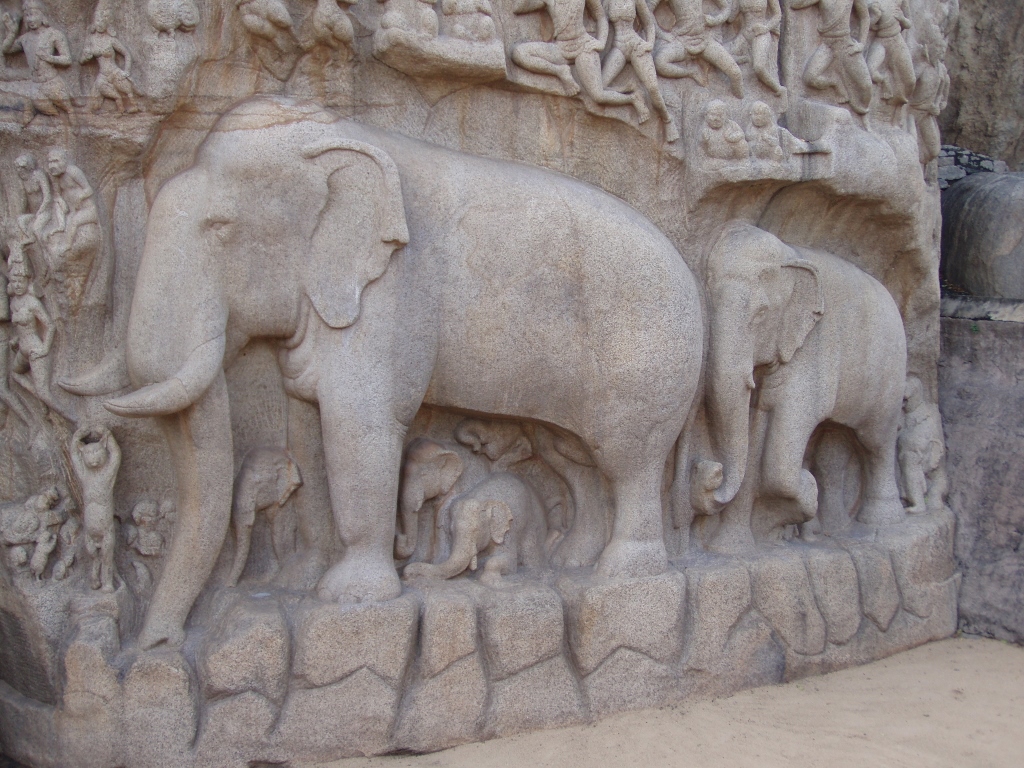 Bhagiratha’s Penance, detail
Bhagiratha’s Penance, detail
Immediately continuing from the bas-relief Bhagiratha’s Penance, there is a cave temple called Panchapandava mandapa (mandapa is a hall/pavilion filled with pillars) and this cave temple carved in the rock in the 7th century is the biggest (unfinished) temple within the Mamallapuram site.
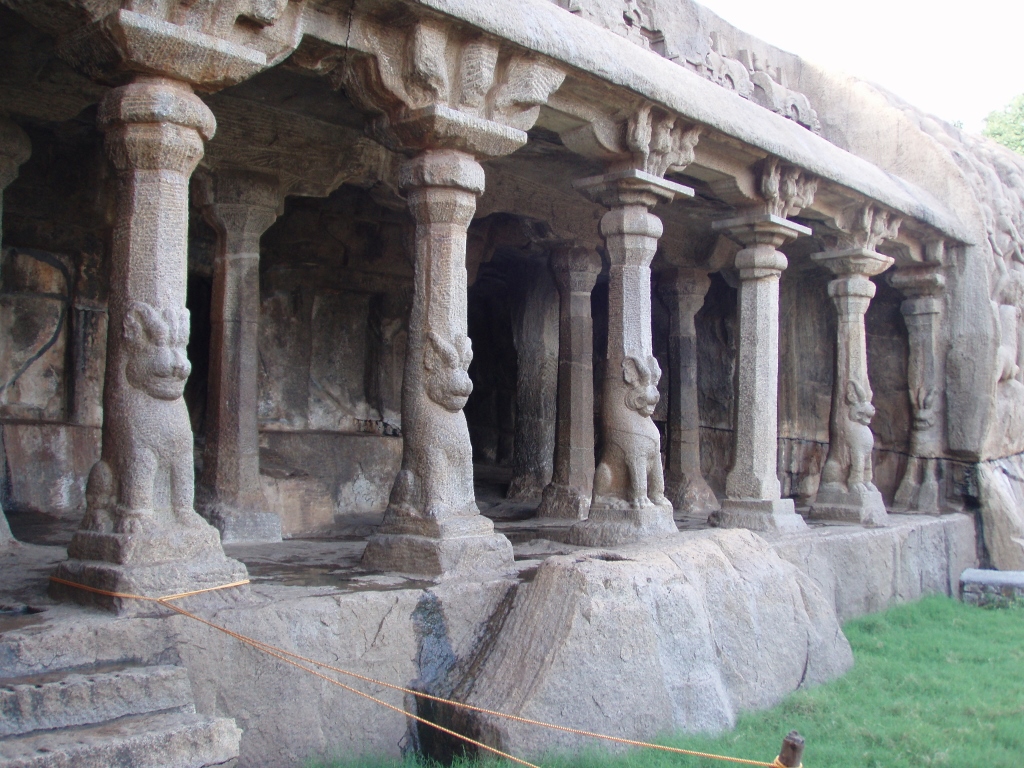 Panchapandava mandapa
Panchapandava mandapa
In the close proximity of this cave temple, there is the next one and that is Krishna Mandapa. This is also a hall/pavilion filled with pillars, but in addition to that there is also a large bas-relief within the temple with visual depictions divided into two segments. One panel shows the god lifting the holy mountain of Govardhan in order to protect people from showers and heavy rains, while the other panel shows the rural life, while above that Krishna plays his flute.
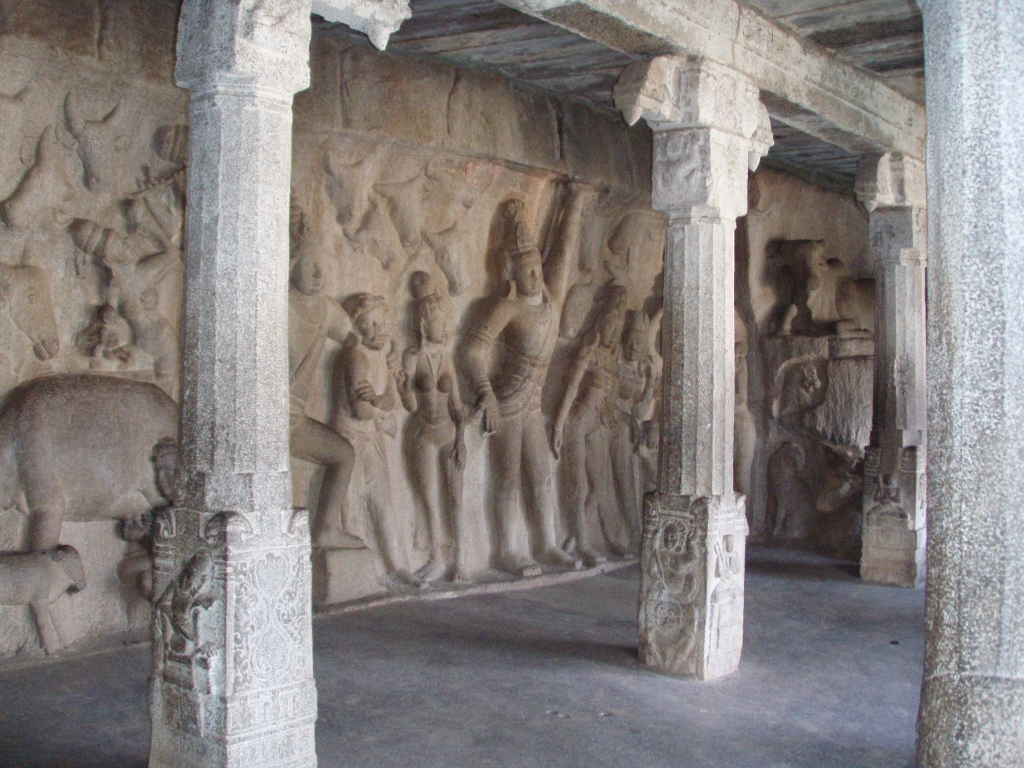 Krishna Mandapa – in the middle Krishna is holding the holy mountain Govardhan with his left arm
Krishna Mandapa – in the middle Krishna is holding the holy mountain Govardhan with his left arm
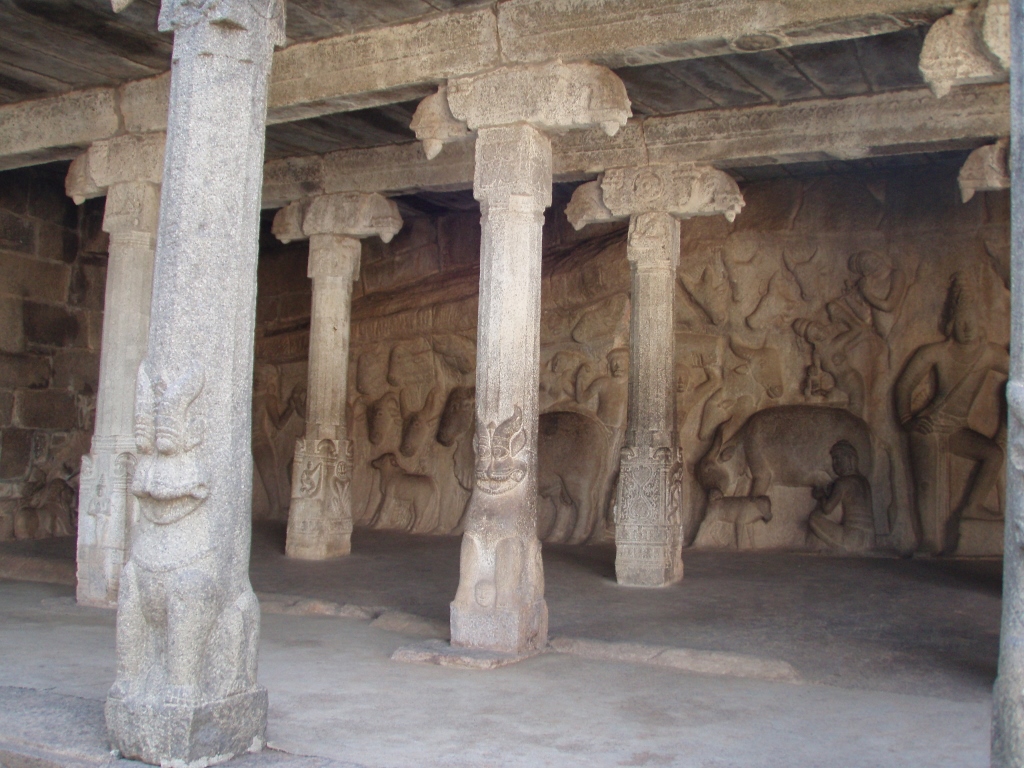 Krishna Mandapa – on the right-hand side, directly above the cowherd who is milking a cow, towards the very top of the bas-relief, there is Krishna who has tilted his head to his right, while holding a flute with his left arm that goes across his chest
Krishna Mandapa – on the right-hand side, directly above the cowherd who is milking a cow, towards the very top of the bas-relief, there is Krishna who has tilted his head to his right, while holding a flute with his left arm that goes across his chest
The next temple we visited is also a cave temple. The reason for all these cave temples is that in a rather flat area in which Mamallapuram is located, there is a group of huge, albeit not too high rocks, practically a hillock made actually of several large barren rocks. In several places that rock hillock has been carved and thus these cave temples, bas-reliefs, stairs, etc. have been made. In addition to all of this, there are also other monuments in the town, like the Shore Temple, that are slightly away from this main hillock.
I found that next temple that is located on the south side of the rock hillock particularly interesting as a pronunciation exercise. Its name is Mahishasuramardini Mandapa.
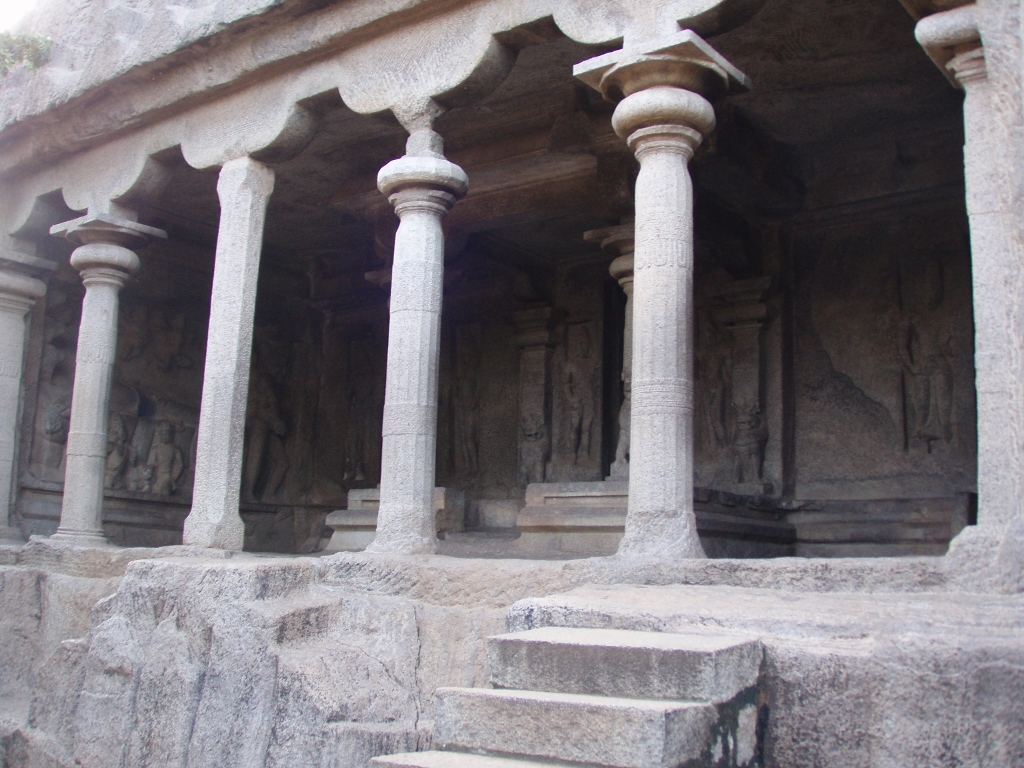 Mahishasuramardini Mandapa
Mahishasuramardini Mandapa
This is a cave temple that was named like this after the panel on the right-hand side wall and it was in fact not the first time that Sneža and I came across this mythical scene. We had already seen the artistic version of this story in Aihole, Karnataka (for comparison sake, see: https://www.svudapodji.com/en/india-10/), but this one here had significantly bigger dimensions. It is the depiction of goddess Durga who, riding her lion, defeats a buffalo-headed demon. Since the buffalo is called Mahisha, goddess Durga (who is actually the invincible avatar of goddess Parvati) in this capacity is called Mahishasuramardini.
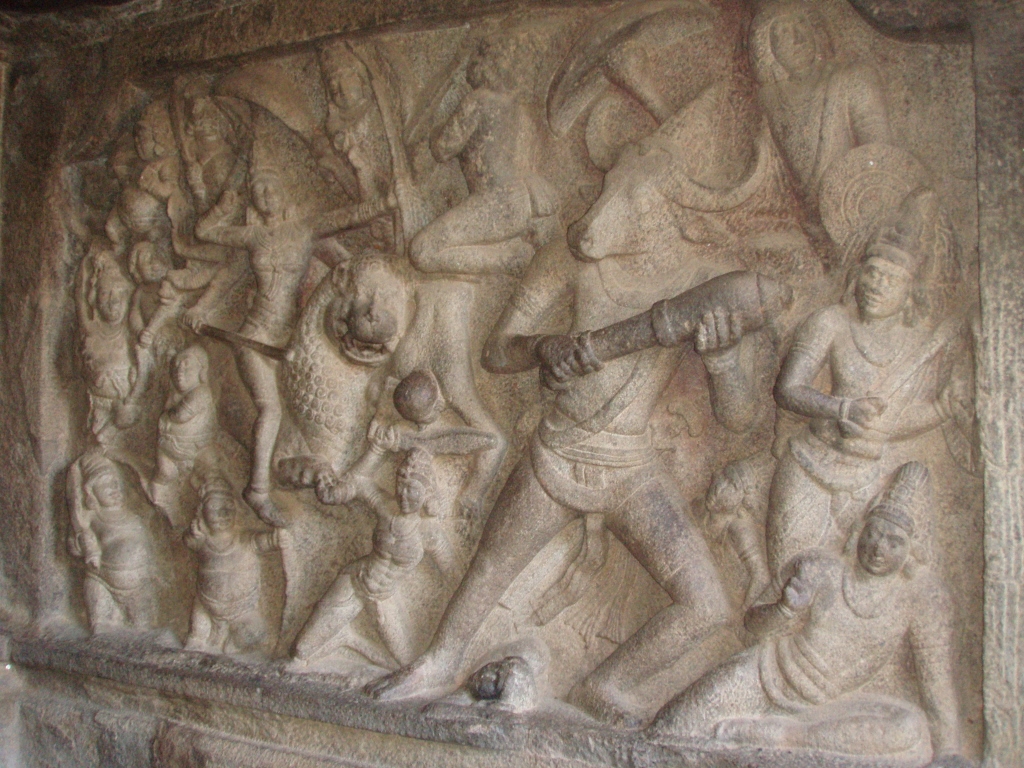 Panel showing goddess Durga killing Mahisha demon
Panel showing goddess Durga killing Mahisha demon
On the opposite side wall, there is a significantly calmer scene which is in Hinduism traditionally called Anantashayi Vishnu. This is the reclining god Vishnu who is in deep meditation before the creation of the earth. God Vishnu is lying on a snake which is in this version called Ananta, although other names are also used for this mythical king of serpents, among others Adishesha. Sneža and I had also seen one other scene in which Vishnu is sitting on Adishesha before, back in Badami, Karnataka (for comparison sake, see: https://www.svudapodji.com/en/india-9/).
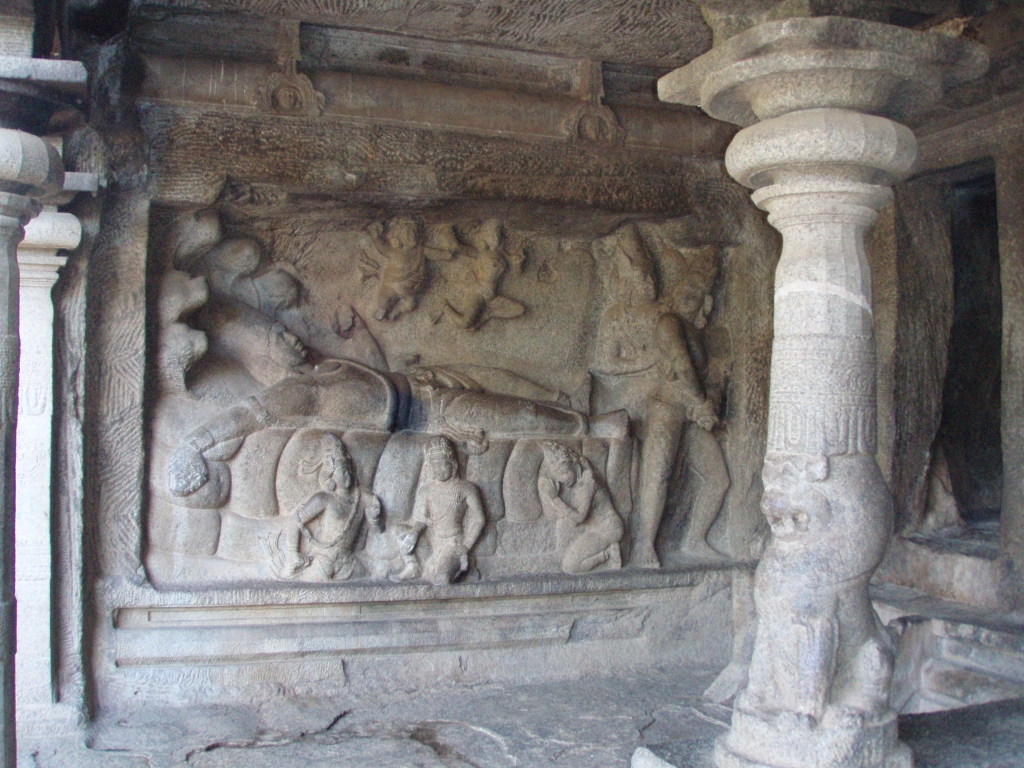 Anantashayi Vishnu: god Vishnu is lying on snake Ananta
Anantashayi Vishnu: god Vishnu is lying on snake Ananta
Directly on the top of the rock in which Mahishasuramardini Mandapa cave has been carved, there is Olakkannesvara Temple from the 8th century.
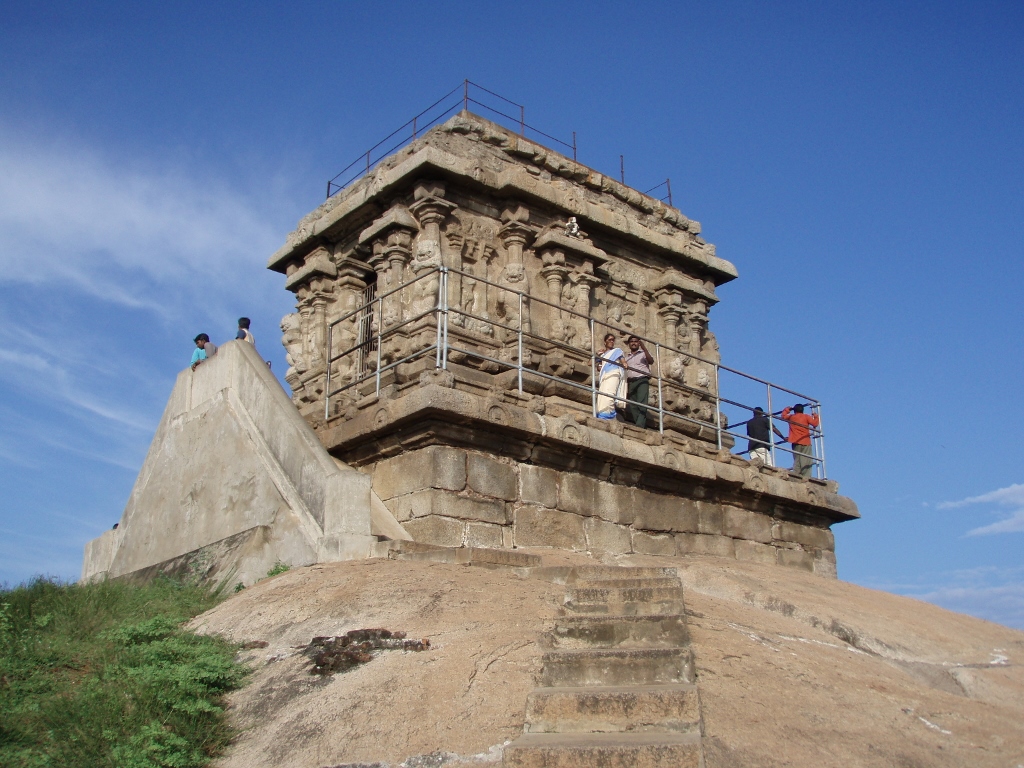 Olakkannesvara Temple
Olakkannesvara Temple
This is yet another structural temple (meaning not carved in the rock). The temple is dedicated to Shiva and it served its function until the 19th century and until 1900, when a new lighthouse was built, the roof of this temple was used for marking the land for the seafarers. Although nowadays the temple is just a pale reflection of what it used to represent, it was worth climbing up, since the view from the terrace around the temple was truly great.
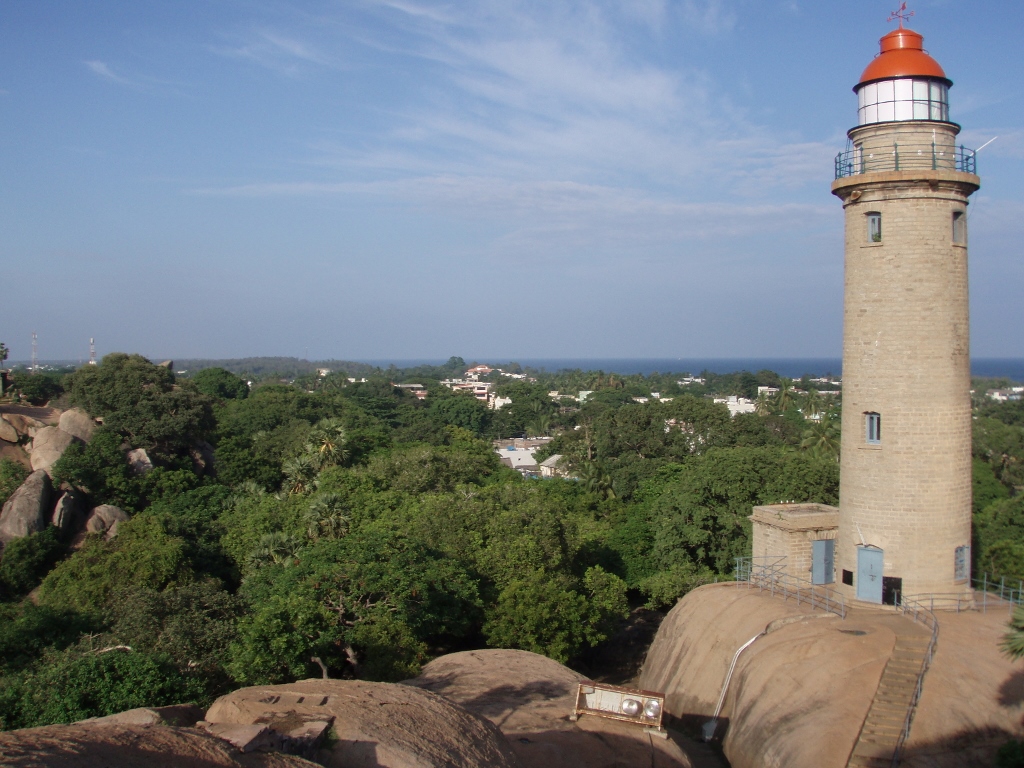 Modern lighthouse, parts of the rock hillock and Mamallapuram at its foot
Modern lighthouse, parts of the rock hillock and Mamallapuram at its foot
Then we went down to the flat area again continuing to circumnavigate the hillock from the west side. Along the way, we also came across a beautifully carved throne in the shape of a lion and I could not help myself and had to sit and lean there.
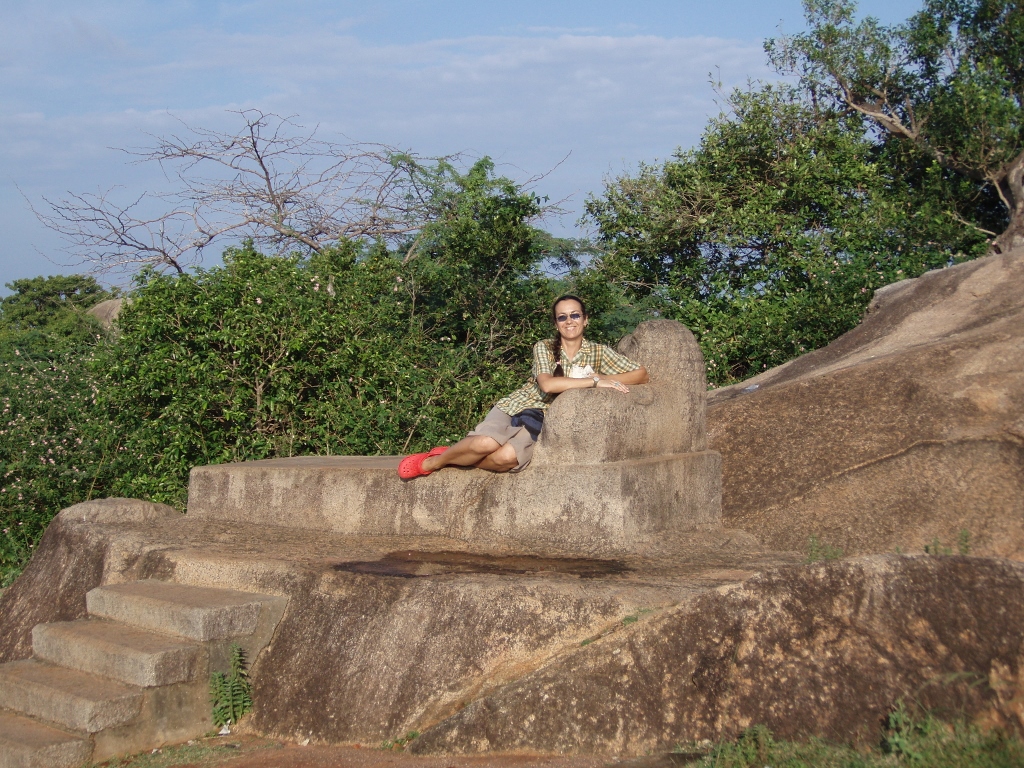 Enjoying on the throne with a lion
Enjoying on the throne with a lion
And so we came to one massive rock that is a true wonder of nature and also has an unusual name. This is in fact a massive boulder around 6 metres high and around 5 metres wide which unbelievably and completely unexpectedly rests stably at a mild slope and yet it does not topple. Moreover, it is said that it has been standing like that in the same spot for over 1200 years, although it is also said that there has been (“smart”) individuals who have wanted and tried (!) to tumble it. I simply wonder what and why actually comes to the mind of such people. Ok, they succeed in pushing the boulder, it falls down to the flat ground and ...? What kind of accomplishment would that be? What kind of idiotic pleasure it would bring to such people? In this way, this boulder represents a fantastic wonder of nature (or gods).
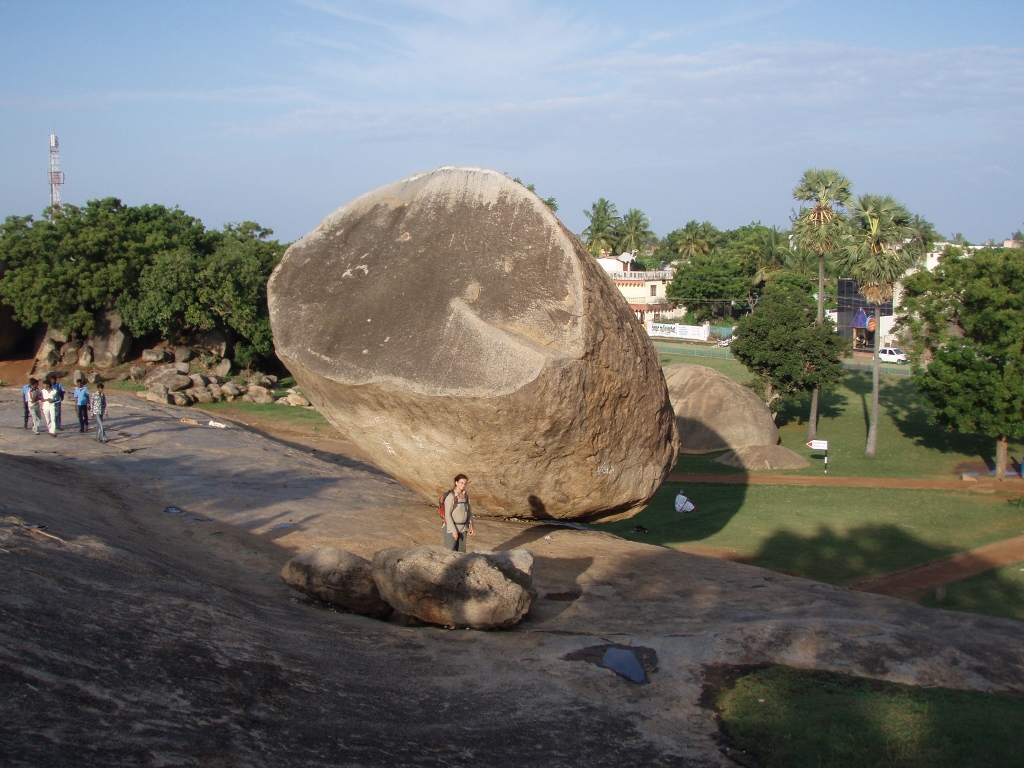 Sneža beside the wondrous boulder
Sneža beside the wondrous boulder
The unusual name of this boulder is Krishna’s Butterball. The reason for this is a legend which says that Krishna really loved butter and had a habit of stealing some from his mother’s special dish and then once a knob of the butter fell down to the Earth. Another name that is used is Vaanirai Kal, which means “Stone of the Sky God.” In any case, it is completely clear that the stone and primarily its utterly unusual position suggest the origin that is out of this world.
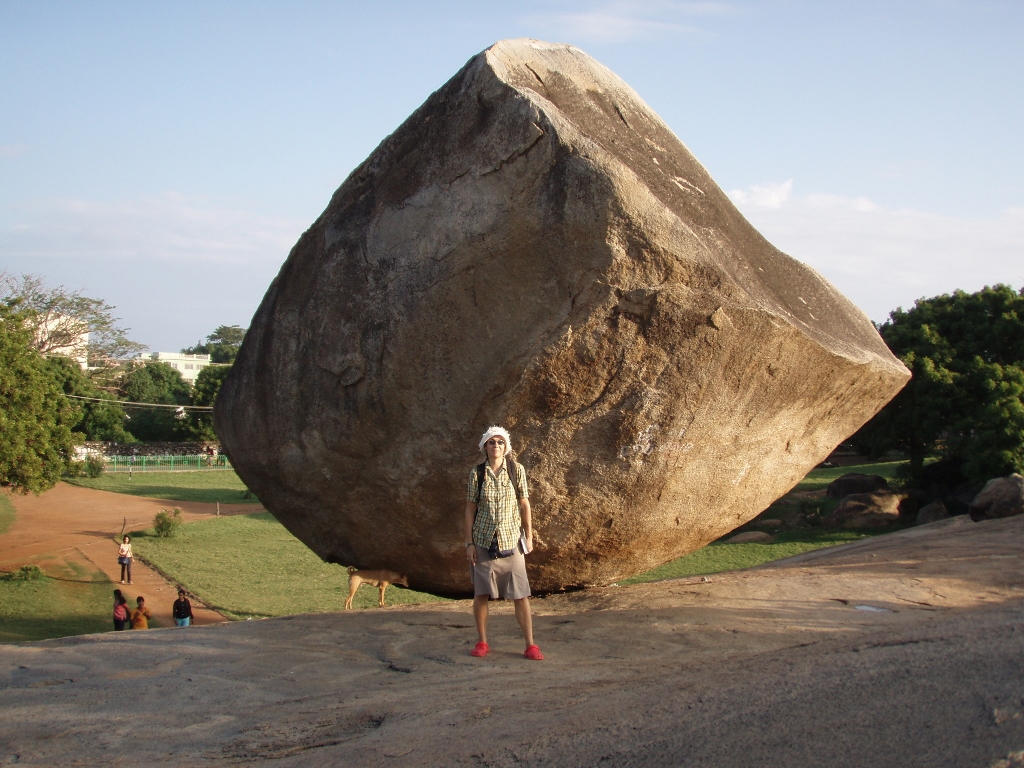 Me beside the wondrous boulder
Me beside the wondrous boulder
Then we continued a little farther in the northbound direction and thus we reached the cave temple named Trimurti Cave Temple. This cave is dedicated to the Hindu trinity: Brahma, Shiva and Vishnu. A part of the temple is dedicated separately to each one of them and, as appropriate, there are celestial guardians standing in front of the entrance.
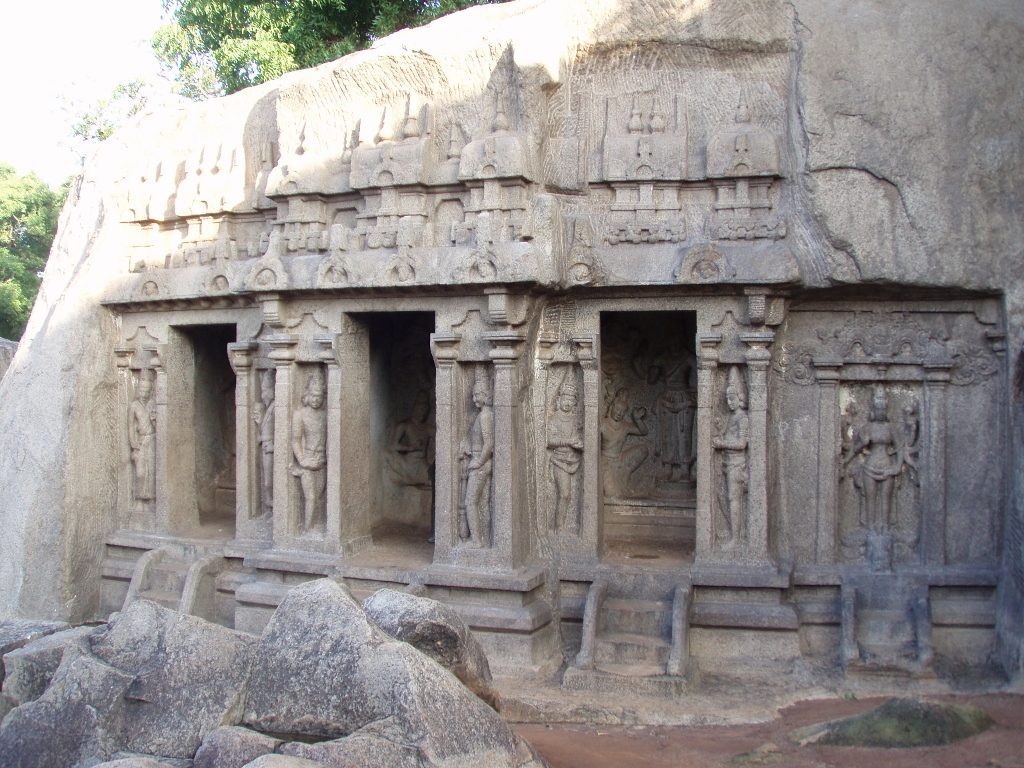 Trimurti Temple
Trimurti Temple
Since this cave temple has been carved out in one relatively smaller rock protruding from the ground and not in the central hillock, right on the opposite side in relation to the temple we saw some very pretty reliefs of elephants and there is also a monkey and (I suppose) a peacock.
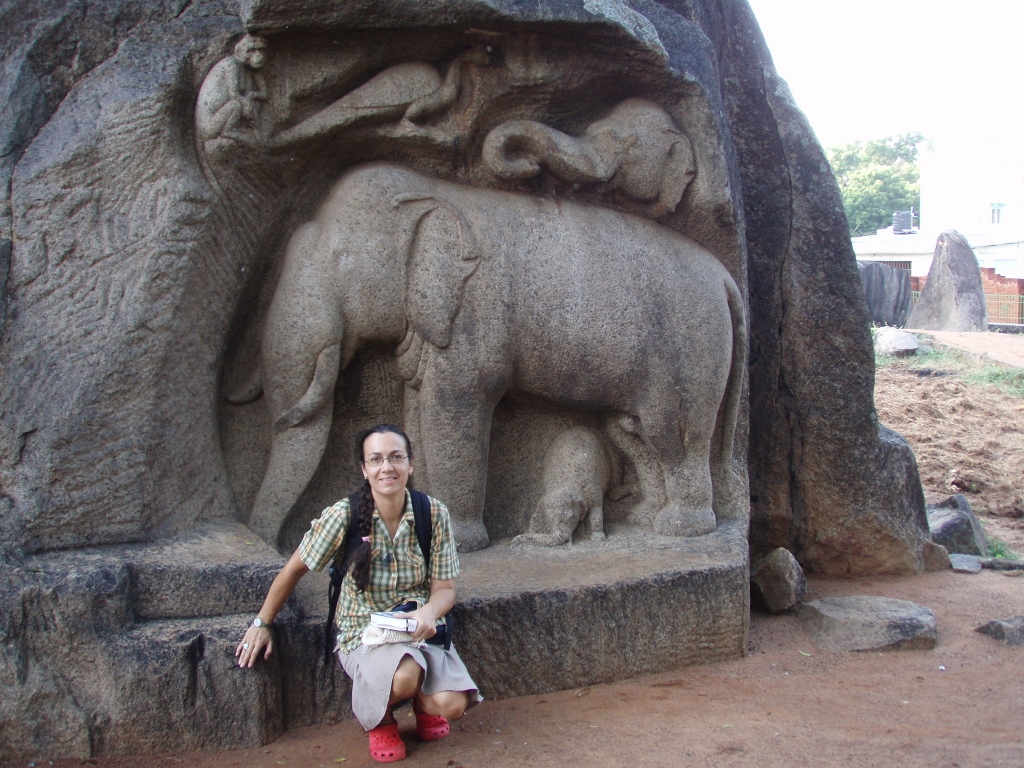 In front of the wonderful relief with animals
In front of the wonderful relief with animals
From there we returned to the park-like section that spreads in front of the slope on which Krishna’s Butterball is standing.
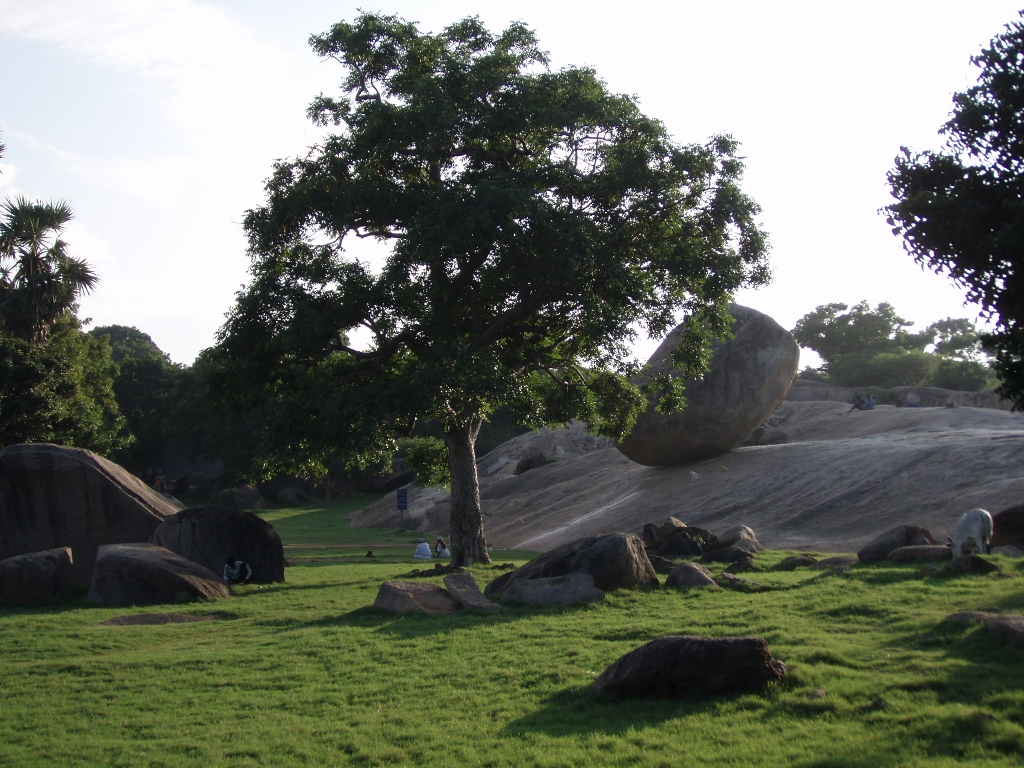 Park within the site; note the incredible position of Krishna’s Butterball
Park within the site; note the incredible position of Krishna’s Butterball
There is also a smallish temple Ganesha Ratha here. On the basis of the inscriptions that have survived in the temple it may be concluded that it was built in the second half of the 7th century and it is presumed it was originally dedicated to Shiva. Over time, Shiva’s lingam has been removed and nowadays in the garbhagriha, the central sanctum, there is Ganesha’s statue which renders the temple with the name.
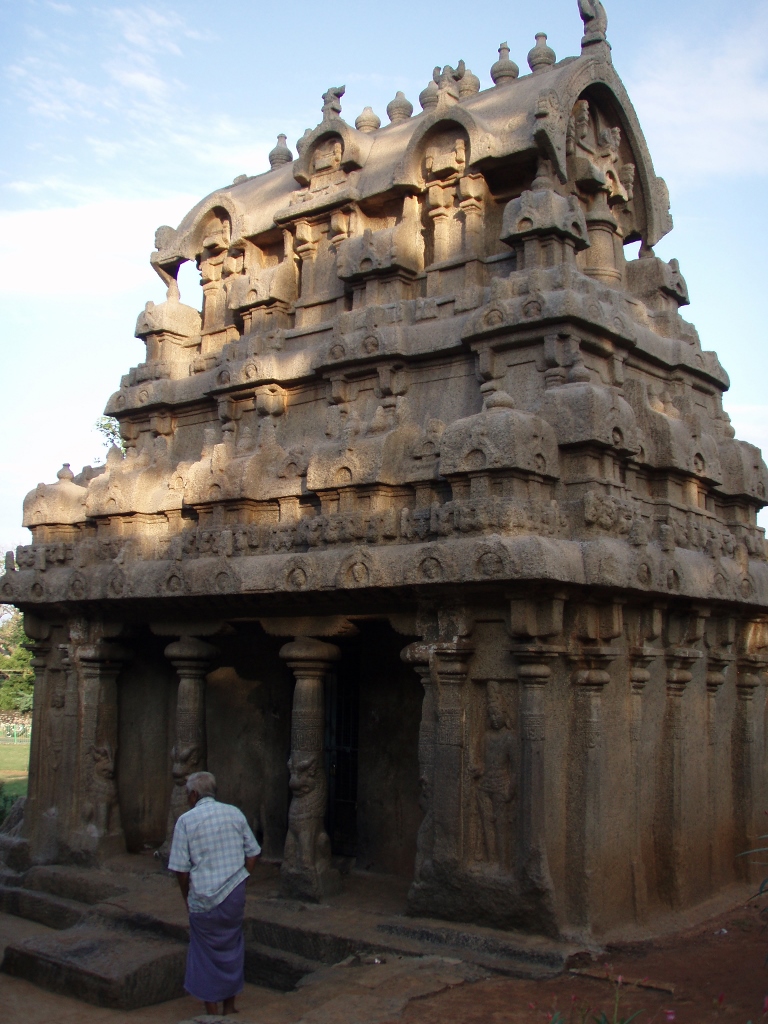 Ganesha Ratha
Ganesha Ratha
And then, following another path, we continued again with the visit of the west part of the central hillock which, as I’ve said, consists of massive rocks and boulders. Soon we came to the cave temple Varaha Temple Cave, thus called after the incarnation of god Vishnu in the form of a wide boar (a version of this was also seen in Badami, https://www.svudapodji.com/en/india-9/).
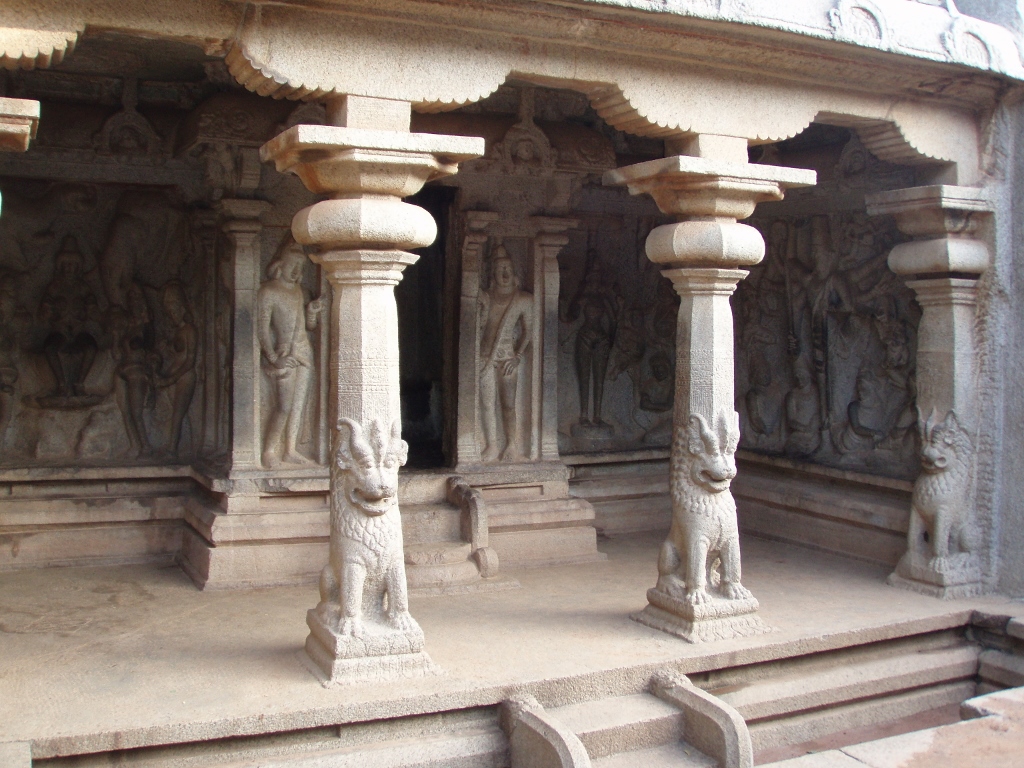 Varaha Temple
Varaha Temple
Although not too big, this was an exceptionally beautiful and opulently decorated temple. On the other hand, while we were there, our attention was caught by two goats that were sunbathing on the “roof” of this temple.
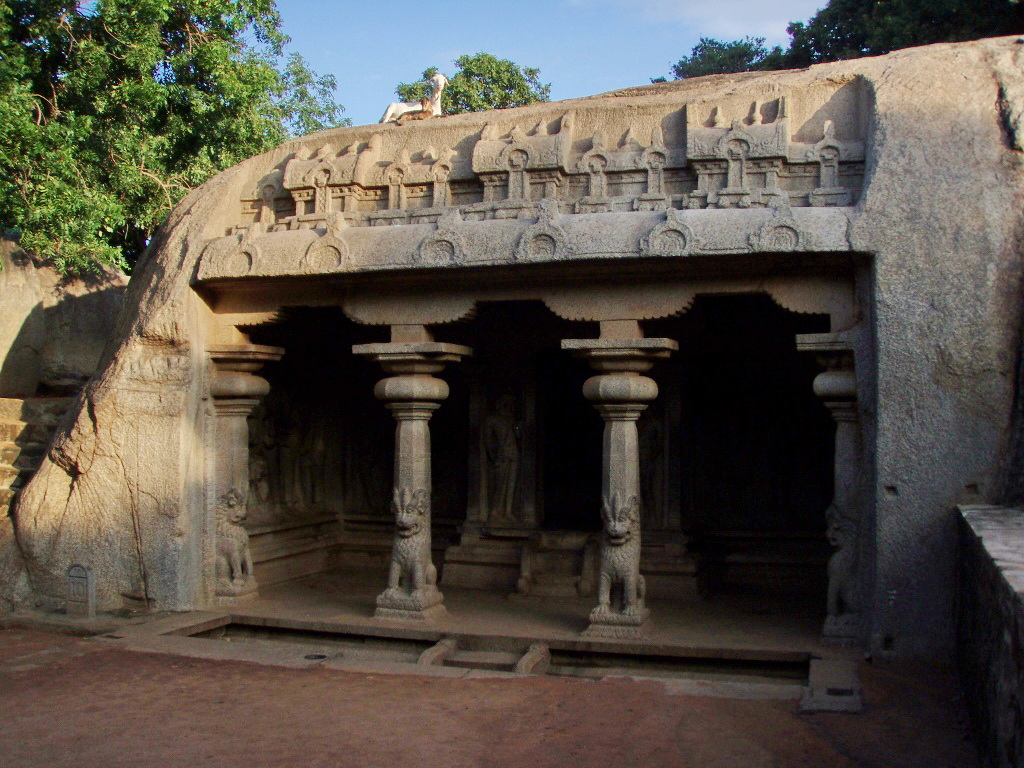 Varaha Temple; note the goats on the “roof” to the left
Varaha Temple; note the goats on the “roof” to the left
Not far from this temple there is also Rayar Gopuram temple, another one of the unfinished structures.
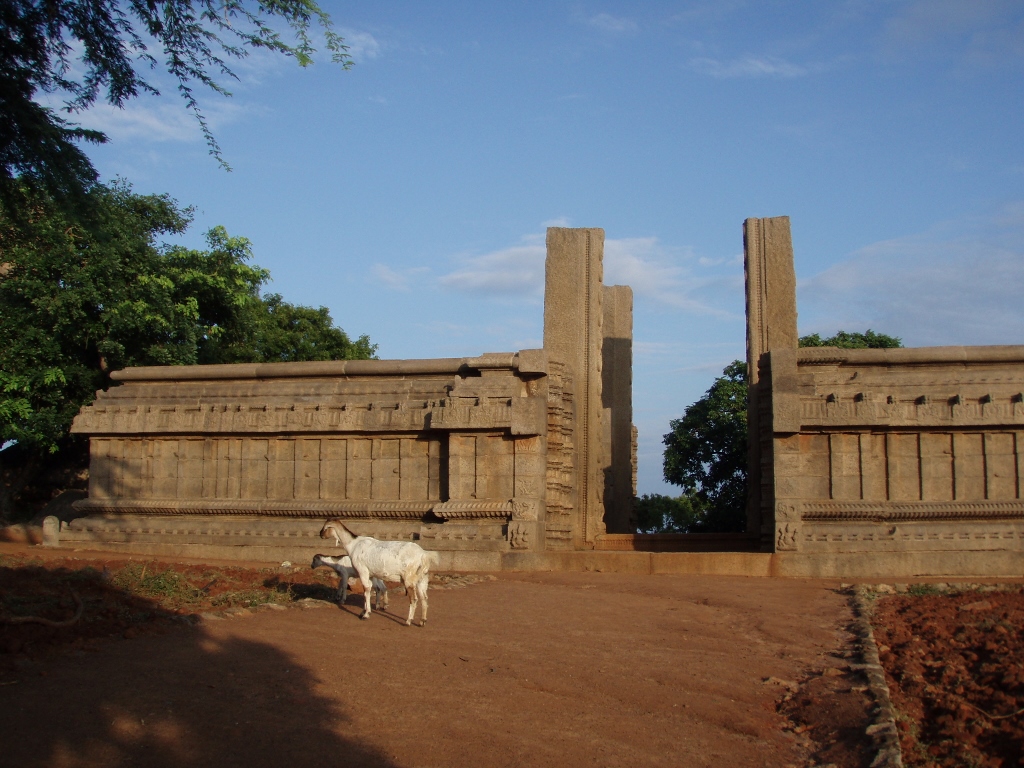 Rayar Gopuram temple, with goats being in charge here as well
Rayar Gopuram temple, with goats being in charge here as well
As it can be seen in the photos, the Sun was slowly setting and therefore the end of the time when the site was opened for visitors was getting nearer. The site of Mamallapuram is quite dispersed and at first it seemed we could visit it nicely following the guidebook, but later it all became confusing, simply because the maps we had and used were not necessarily good and precise. What we did see, and we saw quite a lot, was truly impressive, however, I was very keen on getting to the section of the site called Pancha Rathas. These are (again) temples, there are five of them, each one carved out of one large, monolithic rock and they stand in a group. Admittedly, these monuments are not true temples, as they’ve never been consecrated, but this does not impact their importance in the least.
Worried that I may have skipped them somewhere, I decided to spend the last 15 minutes before the closing of the site dashing along one other part where I thought they may be located and that was the only section we had not visited until then, since I could simply not locate them on the map at all. Sneža had already had enough of temples, so she decided to wait for me by the entrance gate.
Like a fury, I raced across the site, but there was no Pancha Rathas there. Admittedly, along the way I saw another one of the unfinished temples at this site and it was actually very good as an example showing how these cave temples are made.
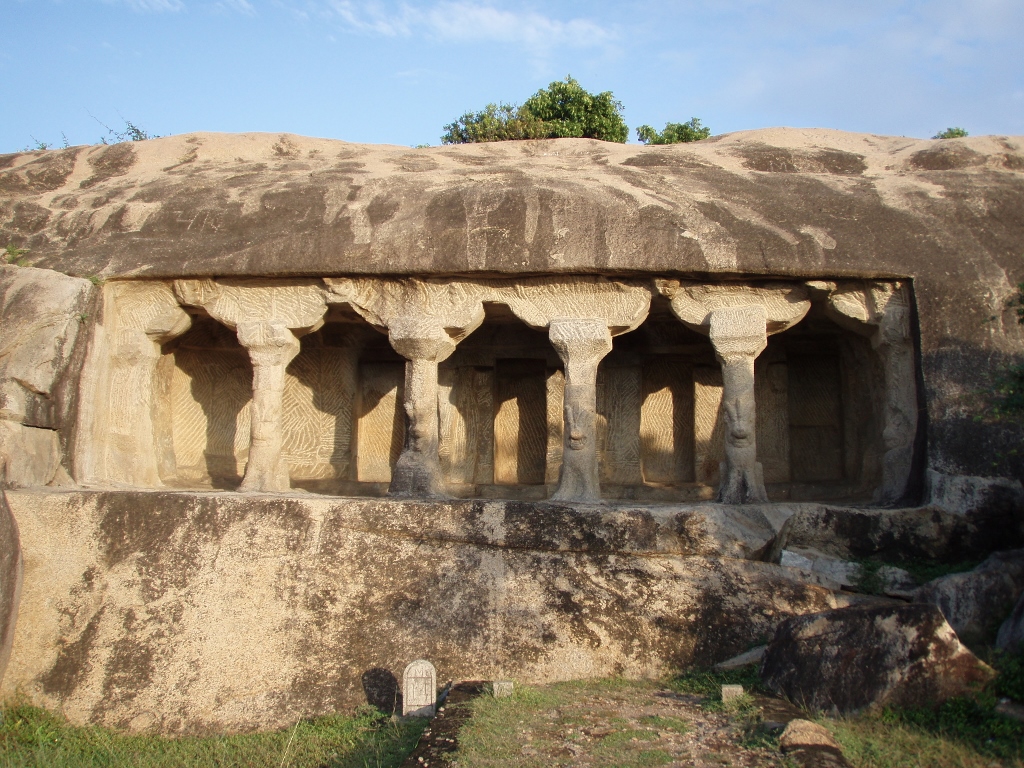 Unfinished temple in Mamallapuram
Unfinished temple in Mamallapuram
It was only later that I managed to find out that the temples from the Pancha Rathas ensemble are a couple of kilometres farther to the south. No wonder I could not locate them on the map that showed only the central part of the town.
Following the sightseeing of the site, we went to the touristy streets in the centre and in the general direction of our hotel. Sneža started with her shopping and I went to an internet café where I also made copies of the photographs as a backup in case my memory cards got damaged. Soon the two of us got together again and then we went for a nice dinner. A little more walking after that and then we could finally retire to the deserved freshness of our room, since the day was again very hot and humid.
In the morning I woke up early and since that was enough sleep for me, I got up and went for a walk along the beach, since our hotel was superbly positioned.
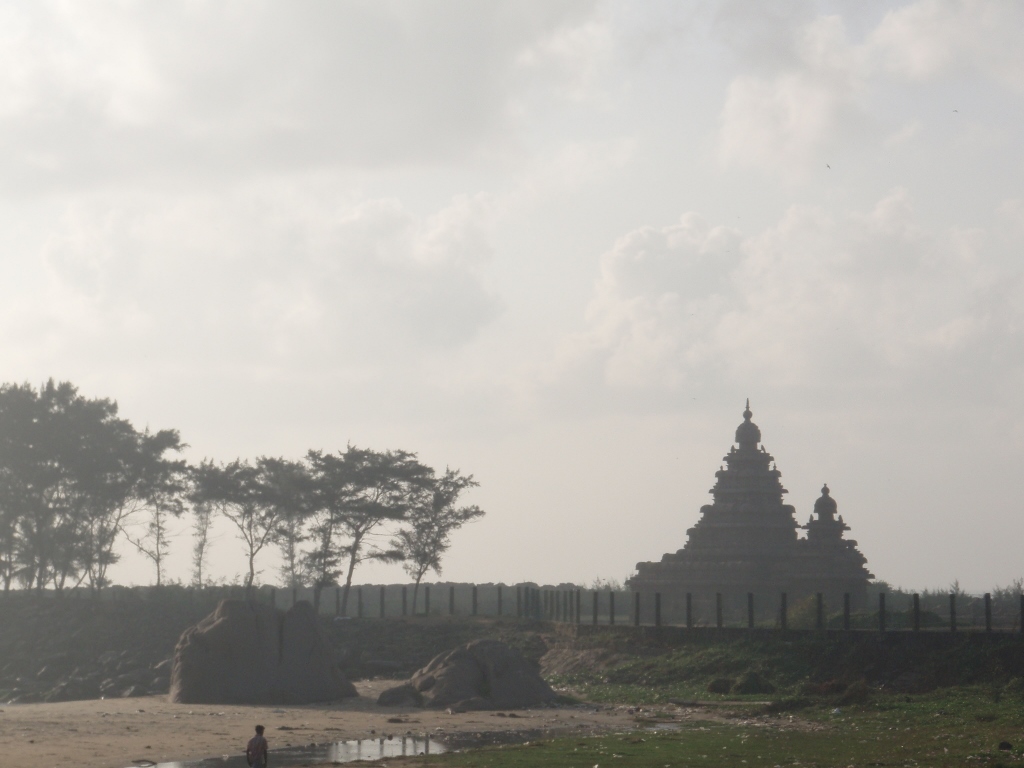 Shore Temple in the early morning
Shore Temple in the early morning
So, I sauntered on the long sandy beach stretching by the Bay of Bengal, the waves were washing the shore, the fishermen were returning from the “night shift” and were pulling their boats onto the beach ...
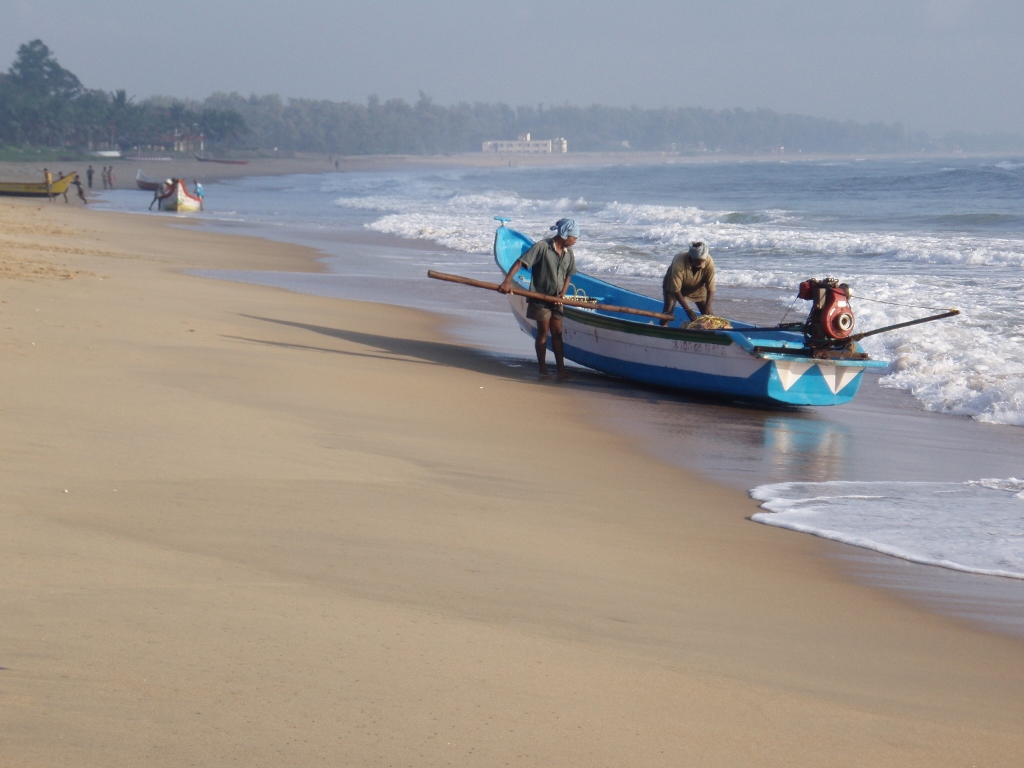 Fishermen are finishing their shift
Fishermen are finishing their shift
... And all of this would be exceptionally nice, even romantic if the whole beach did not seem covered in – shit. (Pardon my French!) At first I wondered if this was a result of a visit of some dogs or some other stray animals, but then I realised that this must have been left by the very same fishermen earlier when they came to work and before getting into their boats. For there were no excrements in the parts of the beach where there were no boats. That’s India, too.
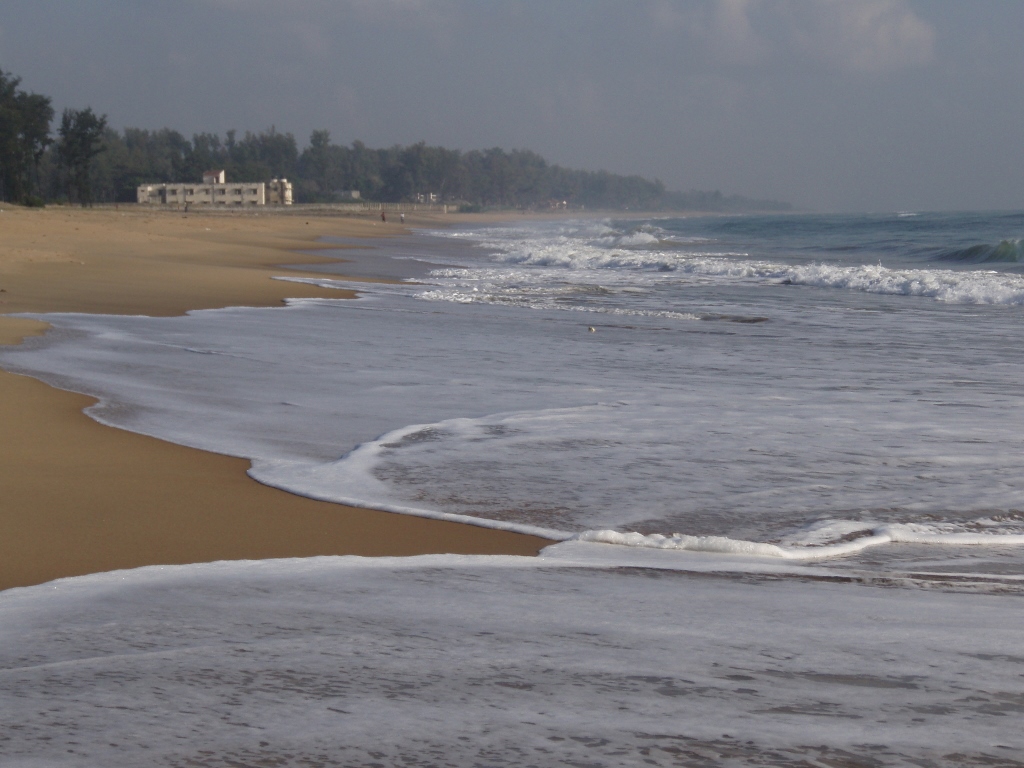 The tide and the waves will wash it all off
The tide and the waves will wash it all off
Very careful as to where I put my feet, I kept on walking for a short while and then I turned and headed back to the hotel.
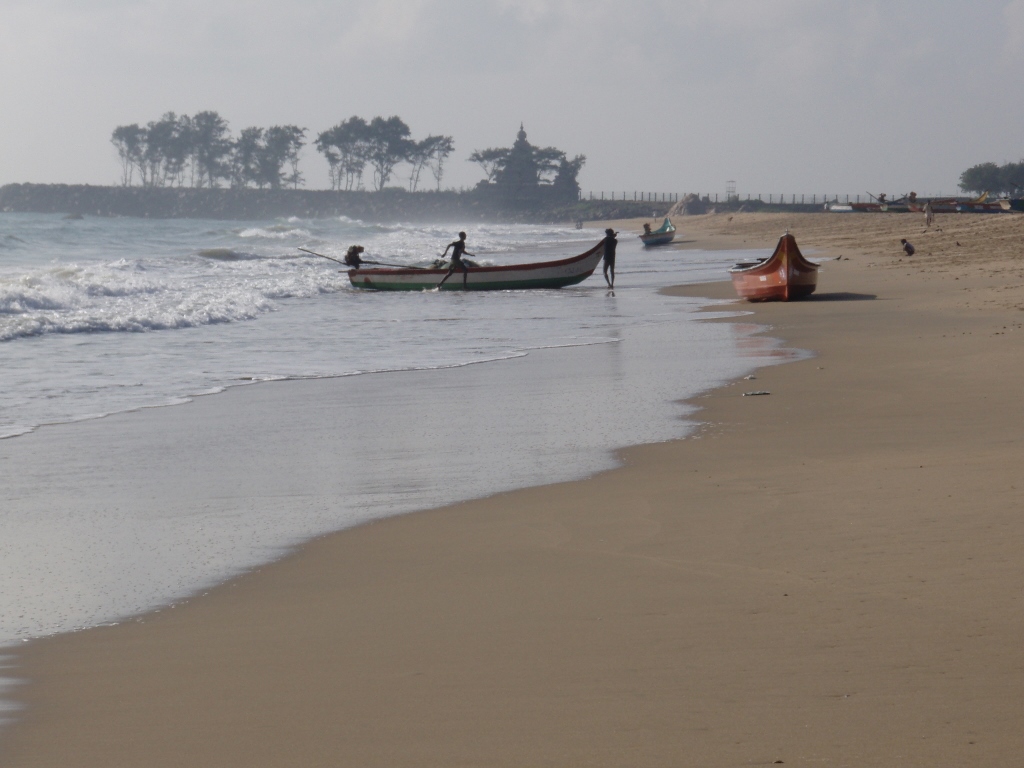 Pulling out of the boats onto the beach with the Shore Temple in the background
Pulling out of the boats onto the beach with the Shore Temple in the background
By the time I had returned from my walk, Sneža was already up. We went for breakfast and got ourselves some bottled water and then we took a taxi to the airport in Chennai, the capital of the federal state Tamil Nadu. There are almost 60 km from Mamallapuram to Chennai, but the two of us did not want to risk not catching the plane, so coaches were out of question on this day. On the other hand, we did not have the time to visit Chennai itself and do some sightseeing there. This is in fact former Madras which was renamed into Chennai in 1996 and this is yet another one of the Indian megacities which together with its suburbs has around 9 million inhabitants.
As I’ve mentioned in part 12 of the story about the journey in India in 2007, the two of us decided to buy plane tickets when we were still in Kochi, federal state Kerala, for a very simple reason – in order to avoid a 30-hour train ride. Namely, our next destination was the city of Aurangabad, in federal state Maharashtra, and that is almost 1200 km to the north-west. Since the planes did not fly right there, we actually bought tickets to the city of Pune with idea to transfer then by coach to Aurangabad, mere 230 km farther away. All in a single day.